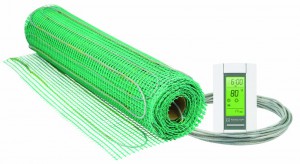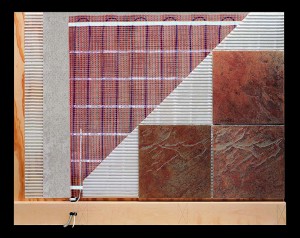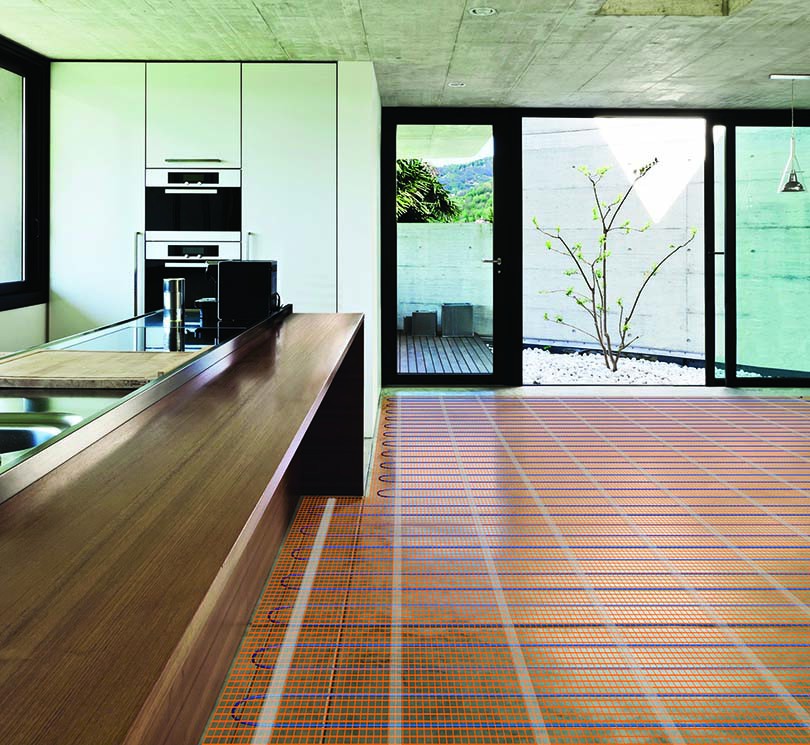By Craig Springer

Electric floor-heating systems are available for a variety of floor surfaces, including tile, stone, carpet and hardwood. Source: WarmlyYours
You could call it the cure for the common cold — cold floors, cold feet and cold houses. Electric radiant floor heat may not be well known in the heating industry, and especially among consumers, but it is not necessarily the newest concept.
It’s been around a while, at least since the Roman Empire. The concept is simple: Heat the flooring and the objects on the floor — the furniture, rugs, carpet, tiles and wood — and they will radiate the warmth into the room. Heat, after all, radiates toward cooler surfaces.
Here’s an example. Grab your hot coffee mug. You can feel the heat from the hot brew not only rising, but also radiating from the sides and the bottom. Radiant energy is a transfer of heat to a cooler surface, in this case with your hot brew, into your hands holding the cup. While heated air rises, the heat itself — the energy — radiates in any direction but always toward a cooler surface.
Your comfort in the home relies not only on the temperature of the air around you, but also on radiant heat transfer. In the depths of winter, your forced-air furnace blows warm air on you, but your feet are cold. That’s because heated air rises and the coolest air swirls around your toes. Radiant heat delivers controlled, comfortable heat without air ducts, dust and noisy furnaces where it matters most: where you live in your home, not at 8 feet above the floor near the ceiling.
Electric radiant heat is installed in a number of ways in the flooring via cables, mats, films or mesh netting, all with a heating element. Through much of the 20th century, hot-water wall radiators were popular for heating homes. You can still find them in old homes, most often as a visual relic or a makeshift plant stand. But with the advent of air-conditioning, heated air was delivered through the same air conditioning ducts, and soon took over and remains dominant.
But radiant heat is seeing a resurgence. The square footage of homes heated in the United States by electric radiant heat is increasing at a steady rate. “About 5 percent per year,” says Mark Eatherton, executive director of the Radiant Professionals Alliance. “Among new housing starts, 5 percent more homes each year are heated by radiant heat.” This steady growth should be no surprise, Eatherton says. “It’s economical. It’s easy to install. It’s reliable.”

This electric radiant heat system is a simple, safe and efficient alternative to mechanical systems or multi-step mortar installation processes. Source: Watts Radiant
For additions to a home, electric panels can be laid easily beneath the flooring. There’s no furnace and there’s no limitation on the flooring type. You can use it under wood, tile or natural stone.
The benefits of radiant heat extend to heating your home where and when you need it. The heating systems can be set with programmable thermostats to economize on energy consumption. Moreover, you can heat the rooms by zoning — heating where you need it when you want it.
While electric radiant panels can be used to heat an entire house, you can also use the technology to heat small problem areas like a cold bathroom, chilly kitchen or drafty sewing room. With the diversity of products and applications, there’s virtually no limit to where the technology can be used. Electric radiant heat in particular solves heating problems for additions and remodels where removing the existing heating source or tapping into it isn’t practical.
And that’s where I recently found myself, facing the problem of heating a new home-office addition but not being able to tap into the existing hydronic radiant heat — a system of water-filled tubes in the foundation heated by a natural-gas boiler. The choices for the addition were few. There was forced air, but that’s loud and dusty and the office would be too much like a motel room with that type of heater. A woodstove had potential, but like the forced-air heaters, dust was a concern. Baseboard heaters were too bulky. They would limit furniture placement and reduce usable square footage in the new addition.
So here’s what we did: research. And that led us to a suite of products developed in Europe and South Africa. Under the hickory floor of our new home office lies a flexible, 1/12-inch-thick heating pad that was rolled out over the underlayment. The heat source is an ultra slim four-layer film of foil, literally rolled out over an underlayment. For do-it-yourself homeowners, it’s a product of merit. It’s warm and quiet and takes up no space at all, save for a programmable thermostat on the wall. These products integrate well with several programmable thermostats operated via your home’s Wi-Fi, such as the popular Nest thermostat.
Other radiant heat sources include mats and films. Some are installed in the concrete between joists and others laid directly under carpet or wood floors. The technology is really starting to catch on in the United States. Through the Scandinavian countries you’ll see that electric radiant heat is quite prevalent. The Nordics even use it to melt ice outside.
Water-based hydronic radiant heat can be cost prohibitive up front. Plumbing and boilers with slurry to cap the piping system are expensive. An electric floor warming system can be put under most floors without major investments.
Not only does electric radiant heat have a benefit on your pocketbook, there are other benefits to using this new technology to heat your home. Without forced-air heating, you’ll see a reduction in allergens, pollutants and dust blowing through your house. Floor warming can reduce dust mite infestations by as much as 80 percent. For allergy sufferers, that’s significant. There are no vents, no drafts, no loud furnaces or boilers and no unsightly vents to hide with curtains, and fewer limitations on furniture placement.
According to the Radiant Professionals Alliance, you could see a reduction in the cost of utilities by using radiant heat over more common heating methods. You’re not forcing air out windows and doors and you are not heating air. You are heating objects — your floor and furnishings are the radiators.
Before you buy, be sure to have a proper system designed and make sure the product can be used for your specific floor coverings. With radiant heat, you’re not spending money on air above your head and you get to keep humid air in your house instead of drying it out with forced air.
And let’s not forget comfort. The Romans were on to something, this cure for the common cold. If your feet are your body’s thermostat, then warm feet warm the body.
Craig Springer lives in Santa Fe County, New Mexico, where he writes about people, nature, outdoors and history.

